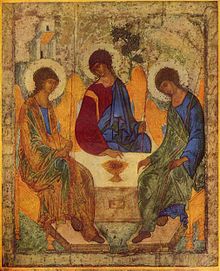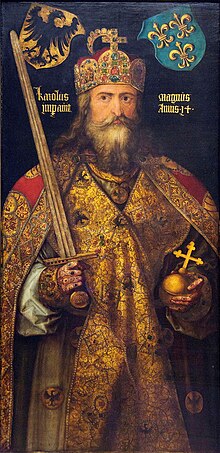Christianity in the 8th century
Christianity in the 8th century was much affected by the rise of Islam in the Middle East. By the late 8th century, the
Though the
Second Council of Nicea

The
Sometime between 726 and 730 the Byzantine Emperor Leo III the Isaurian ordered the removal of an image of Jesus prominently placed over the Chalke gate, the ceremonial entrance to the Great Palace of Constantinople, and its replacement with a cross. This was followed by orders banning the pictorial representation of the family of Christ, subsequent Christian saints, and biblical scenes. The Council of Hieria had been held under the iconoclast Emperor Constantine V. It met with more than 340 bishops at Constantinople and Hieria in 754, declaring the making of icons of Jesus or the saints an error, mainly for Christological reasons.
Iconoclasm
Two prototypes of icons would be the

- Patriarch Germanus I of Constantinople
- John of Damascus
John of Damascus
In the
Tensions between East and West
In the early 8th century,
Spread of Christianity
Anglo-Saxons
The
In the 8th century, the
Eventually, the conversion was imposed by armed force and successfully completed by
Frankish Empire

By the 8th century, the
Christian missionaries to the Frankish Empire include:
- Saint Boniface
- Saint Winibald(English siblings assisting Boniface)
- Wilfrid
- Willibrord
- Willehad of Bremen
- Lebuinus
- Saint Ludger
- Suitbert of Kaiserwerdt
- Saint Pirmin
- Saint Corbinian
Although the
Netherlands and non-Frankish Germany
In 698 the
Much of Willibrord's work was wiped out when the pagan
China
The
Christianity and Islam
Missionary expansion
Once the Christian faith had been established in the valleys of the Oxus and
Iberian Peninsula and the Reconquista
Between 711 and 718 the
The Arabs, under the command of the
The rulers of Al-Andalus were granted the rank of
Timeline
- 716 - Germanic tribes[8]
- 718-1492 Reconquista, Iberian Peninsula retaken by with active encouragement from Christian authorities
- 718 evangelize the Germans
- 720? Disentis Abbey of Switzerland
- 720 - Caliph Berbers to convert to Islam
- 724 - Boniface fells pagan sacred oak of Thor at Geismar in Hesse (Germany)[9]
- 730-787 First Iconoclasm, Byzantine Emperor Leo III bans Christian icons, Pope Gregory II excommunicates him
- 731 English Church History written by Bede
- 740 - Irish monks reach Iceland[10]
- 750? Tower added to St Peter's Basilica at the front of the atrium
- 752? Donation of Constantine, granted Western Roman Empire to the Pope, later proved a forgery
- 756 Donation of Pepin recognizes Papal States
- 771 - Charlemagne becomes king and will decree that sermons be given in the vernacular. He also commissioned Bible translations.[11]
- 781 - Luminous Religion, thus providing a written record of a Christian presence in China[12]
- 787 - Liudger begins missionary work among the pagans near the mouth of the Ems river (in modern day Germany)[13]
- 787 ecumenical, ends first Iconoclasm
- 793 Sacking of the monastery of Viking raids on Christendom.
- 800 King Charlemagne of the Franks is crowned first Holy Roman Emperor of the West by Pope Leo III.
See also
- History of Christianity
- History of the Roman Catholic Church
- History of the Eastern Orthodox Church
- History of Christian theology
- History of Oriental Orthodoxy
- Church Fathers
- List of Church Fathers
- Christian monasticism
- Patristics
- Christianization
- History of Calvinist-Arminian debate
- Timeline of Christianity
- Timeline of Christian missions
- Timeline of the Roman Catholic Church
- Chronological list of saints in the 8th century
Notes and references
- ^ Epitome, Iconoclast Council at Hieria, 754
- ^ Protopresbyter Alexander Schmemann: Byzantium, Iconoclasm and the Monks
- ^ No Graven Image
- ^ Vidmar, Jedin 34
- ^ a b Schön 2004, 170
- ^ Schön 2004, 172
- ^ Collins (2004), 139.
- ^ Tucker, 2004, p. 55
- ^ Neill, p. 64
- ^ Moreau, p. 467
- ^ Herzog, p. 351
- ^ Neill, Stephen A History of Christian Missions, p. 82, Penguin Books, 1986
- ^ Herbermann, p. 415
Further reading
- Lawrence, C. H. Medieval Monasticism. 3rd ed. Harlow: Pearson Education, 2001. ISBN 0-582-40427-4
- Kaplan, Steven 1984 Monastic Holy Man and the Christianization of Early Solomonic Ethiopia (in series Studien zur Kulturkunde) ISBN 3-515-03934-1
- Fletcher, Richard, The Conversion of Europe. From Paganism to Christianity 371-1386 AD. London 1997.
- Padberg, Lutz v., (1998): Die Christianisierung Europas im Mittelalter, Stuttgart, Reclam (German)
